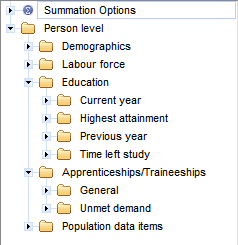 FILE STRUCTURE
FILE STRUCTURE
NOT APPLICABLE CATEGORIES
TABLE POPULATIONS
ZERO VALUE CELLS
The underlying format of the 2012 Survey of Education and Work TableBuilder file is structured as a single person level. This person level contains general demographic information about each survey respondent such as their age, sex, country of birth and labour force status as well details about their qualifications and other recent educational activity.
When tabulating data from TableBuilder, person weights are automatically applied to the underlying sample counts to provide the survey's population estimates.
The data items included in the 2012 SEW TableBuilder are grouped under the following broad headings and subheadings. A complete data item list can be accessed from the Downloads page.

NOT APPLICABLE CATEGORIES
Most data items included in TableBuilder include a 'Not applicable' category. The classification values of the 'Not applicable' categories, where relevant, are shown in the data item list in the Downloads tab. The "Not Applicable" category generally represents the number of people who were not asked a particular question or the number of people excluded from the population for a data item when that data was derived (e.g. Year of Arrival in Australia is not applicable for people born in Australia).
TABLE POPULATIONS
The population relevant to each data item is identified in the data item list and should be kept in mind when extracting and analysing data. The actual population count for each data item is equal to the total cumulative frequency minus the 'Not applicable' category.
Generally, all populations, including very specific populations, can be 'filtered' using other relevant data items. For example, if the population of interest is 'Employed persons', any data item with that population (excluding the 'Not applicable' category) could be used. While any applicable data item can be used for this filtering process, the SEW TableBuilder also includes some data items that have been specifically derived for this purpose. For example, the population data item "P7. Persons aged 15–24 years" can be used to filter this population rather than the actual age group data item. The specifically derived population data items are listed in the data item list in the "Population data items" worksheet.
ZERO VALUE CELLS
Tables generated from sample surveys will sometimes contain cells with zero values because no respondents that satisfied the parameters of a particular cell in a table were in the survey. This is despite there being people in the general population with those characteristics. That is, the cell may have had a value above zero if all persons in scope of the survey had been enumerated. This is an example of sampling variability which occurs with all sample surveys. Relative Standard Errors cannot be generated for zero cells.
 Print Page
Print Page
 Print All
Print All
 Quality Declaration
Quality Declaration